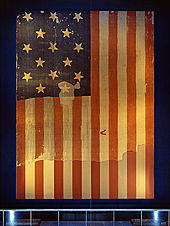The Star Spangled Banner
O! Say Can You See? The Star Spangled Banner came from a dark time in American history. The War of 1812 wasn’t going well for the United States. It was 1814 and the British had won the Battle of Bladensburg. The British force led by Major General Robert Ross occupied Washington, D.C. and set fire to many public buildings including the White House and the Treasury.
President Madison dispatched Francis Scott Key and John Stuart Skinner to meet with Major General Ross to set up a prisoner swap. They met aboard the British flagship HMS Tonnant and eventually negotiated a deal.

While negotiating, Key and Skinner had heard some of the plans for the British attack on Baltimore and the British didn’t want to release them until after the bombardment. British gunboats tried to slip by the defenses during the night. Key watched bomb blasts and artillery lit up Fort McHenry periodically through the night and noted that the small storm flag was still visible. Darkness prevented him from seeing if the flag was still flying after the illumination from the bombardment ended.
As dawn broke, Key saw that the smaller storm flag had been replaced by a larger full size American Flag flying over the fort. Inspired by sight of the flag that signaled victory, Key started writing a poem on the back of an envelope that he finished later and called “Defence of Fort McHenry”. It was later set to music and was later used by the Navy during the raising and lowering of the flag. It wasn’t until 1916 that President Woodrow Wilson designated that it be plaid at other military events. In 1918, The Star Spangled Banner was played during the 7th inning stretch of the World Series, and later became a tradition at all ball gamed during World War II.
Years later, Key said in a speech:
“I saw the flag of my country waving over a city-the strength and pride of my native State-a city devoted to plunder and desolation by its assailants. I witnessed the preparation for its assaults. I saw the array of its enemies as they advanced to the attack. I heard the sound of battle; the noise of the conflict fell upon my listening ear, and told me that ‘the brave and the free’ had met the invaders.”
The flag that inspired Francis Scott Key’s poem came to be known as the Star Spangled Banner Flag. You can see it today on display in the National Museum of American History.